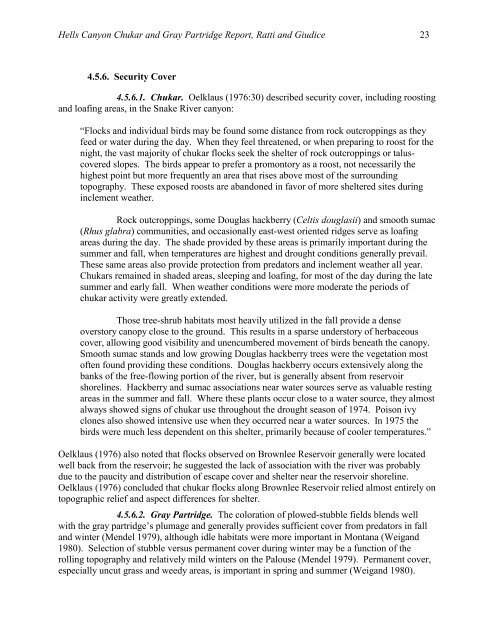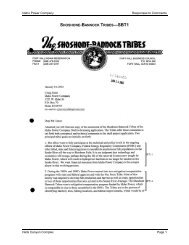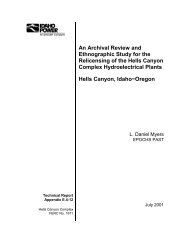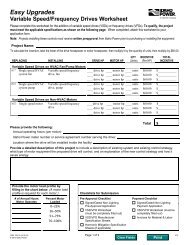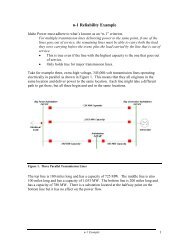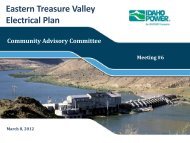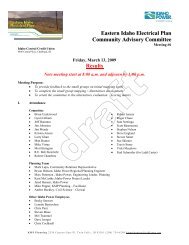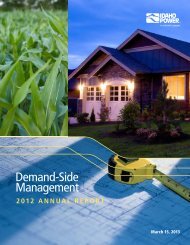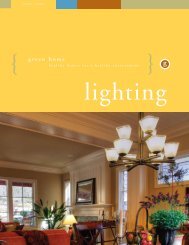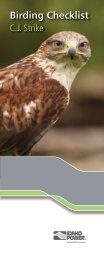Assessment of Chukar and Gray Partridge Populations - Idaho Power
Assessment of Chukar and Gray Partridge Populations - Idaho Power
Assessment of Chukar and Gray Partridge Populations - Idaho Power
- No tags were found...
You also want an ePaper? Increase the reach of your titles
YUMPU automatically turns print PDFs into web optimized ePapers that Google loves.
Hells Canyon <strong>Chukar</strong> <strong>and</strong> <strong>Gray</strong> <strong>Partridge</strong> Report, Ratti <strong>and</strong> Giudice 234.5.6. Security Cover4.5.6.1. <strong>Chukar</strong>. Oelklaus (1976:30) described security cover, including roosting<strong>and</strong> loafing areas, in the Snake River canyon:“Flocks <strong>and</strong> individual birds may be found some distance from rock outcroppings as theyfeed or water during the day. When they feel threatened, or when preparing to roost for thenight, the vast majority <strong>of</strong> chukar flocks seek the shelter <strong>of</strong> rock outcroppings or taluscoveredslopes. The birds appear to prefer a promontory as a roost, not necessarily thehighest point but more frequently an area that rises above most <strong>of</strong> the surroundingtopography. These exposed roosts are ab<strong>and</strong>oned in favor <strong>of</strong> more sheltered sites duringinclement weather.Rock outcroppings, some Douglas hackberry (Celtis douglasii) <strong>and</strong> smooth sumac(Rhus glabra) communities, <strong>and</strong> occasionally east-west oriented ridges serve as loafingareas during the day. The shade provided by these areas is primarily important during thesummer <strong>and</strong> fall, when temperatures are highest <strong>and</strong> drought conditions generally prevail.These same areas also provide protection from predators <strong>and</strong> inclement weather all year.<strong>Chukar</strong>s remained in shaded areas, sleeping <strong>and</strong> loafing, for most <strong>of</strong> the day during the latesummer <strong>and</strong> early fall. When weather conditions were more moderate the periods <strong>of</strong>chukar activity were greatly extended.Those tree-shrub habitats most heavily utilized in the fall provide a denseoverstory canopy close to the ground. This results in a sparse understory <strong>of</strong> herbaceouscover, allowing good visibility <strong>and</strong> unencumbered movement <strong>of</strong> birds beneath the canopy.Smooth sumac st<strong>and</strong>s <strong>and</strong> low growing Douglas hackberry trees were the vegetation most<strong>of</strong>ten found providing these conditions. Douglas hackberry occurs extensively along thebanks <strong>of</strong> the free-flowing portion <strong>of</strong> the river, but is generally absent from reservoirshorelines. Hackberry <strong>and</strong> sumac associations near water sources serve as valuable restingareas in the summer <strong>and</strong> fall. Where these plants occur close to a water source, they almostalways showed signs <strong>of</strong> chukar use throughout the drought season <strong>of</strong> 1974. Poison ivyclones also showed intensive use when they occurred near a water sources. In 1975 thebirds were much less dependent on this shelter, primarily because <strong>of</strong> cooler temperatures.”Oelklaus (1976) also noted that flocks observed on Brownlee Reservoir generally were locatedwell back from the reservoir; he suggested the lack <strong>of</strong> association with the river was probablydue to the paucity <strong>and</strong> distribution <strong>of</strong> escape cover <strong>and</strong> shelter near the reservoir shoreline.Oelklaus (1976) concluded that chukar flocks along Brownlee Reservoir relied almost entirely ontopographic relief <strong>and</strong> aspect differences for shelter.4.5.6.2. <strong>Gray</strong> <strong>Partridge</strong>. The coloration <strong>of</strong> plowed-stubble fields blends wellwith the gray partridge’s plumage <strong>and</strong> generally provides sufficient cover from predators in fall<strong>and</strong> winter (Mendel 1979), although idle habitats were more important in Montana (Weig<strong>and</strong>1980). Selection <strong>of</strong> stubble versus permanent cover during winter may be a function <strong>of</strong> therolling topography <strong>and</strong> relatively mild winters on the Palouse (Mendel 1979). Permanent cover,especially uncut grass <strong>and</strong> weedy areas, is important in spring <strong>and</strong> summer (Weig<strong>and</strong> 1980).


